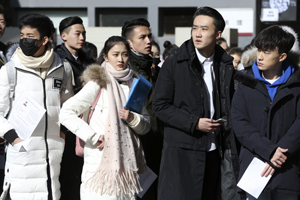Shanghai begins culling poultry
SHANGHAI - Authorities in Shanghai on Thursday closed a live poultry trading zone in an agricultural products market and began slaughtering all birds there after detecting H7N9 bird flu virus from samples of pigeon from the market.
Meanwhile, a person who had close contact with a dead H7N9 bird flu patient in Shanghai has been under treatment in quarantine after developing symptoms of fever, running nose and throat itching, the Shanghai Municipal Health and Family Planning Commission said late Thursday.
China's Ministry of Agriculture said Thursday it found the H7N9 virus from pigeon samples collected at the Huhuai wholesale agricultural products market in Songjiang district of Shanghai.
After gene sequence analysis, the national avian flu reference laboratory concluded that the strain of the H7N9 virus found on pigeons was highly congenetic with those found on persons infected with H7N9 virus, the ministry said.
The Shanghai municipal agricultural commission said it has ordered proper disposal of the culled birds, their excrements and contaminated food as well as disinfection of the market and vehicles that carried them and other things that have contacts with them.
The commission will also investigate and track where the pigeons came from, it said.
Meanwhile, the agency ordered the closure of the live poultry trading areas of two markets in Minhang district after samples there were found with H7 bird flu virus.Shanghai reported two more deaths from the H7N9 bird flu Thursday,bringing the death toll from the new deadly strain to five around the country.
The city has reported six infections to date, and four have died, according to the Shanghai Municipal Health and Family Planning Commission.
Of the rest two, a 67-year-old woman was in critical condition and a four-year-old baby was recovering from mild illness, it added.
Of the latest two deaths, a 52-year-old woman surnamed Yu died at Huashan Hospital on Wednesday and was confirmed infected with the H7N9 strain on Thursday.
Yu developed a low fever on March 27 and sent to an intensive care unit of Huashan Hospital on April 2. She died on the following day.
The other case involved a 48-year-old man surnamed Chu, a poultry transporter from Rugao in neighboring Jiangsu province.
He developed symptoms of cough on March 28. After having a fever on Monday, he went to a private clinic for treatment. The man then sought help in the Tongji Hospital in Shanghai in the early hours of Wednesday after his condition worsened.
Chu died three hours after being admitted to the hospital. He was confirmed infected with the H7N9 virus on Thursday. Eight people who had close contact with him have shown no abnormal symptoms.
So far, China has confirmed 14 H7N9 cases - six in Shanghai, four in Jiangsu, three in Zhejiang and one in Anhui, in the first known human infections of the lesser-known strain. Of all, four died in Shanghai and one died in Zhejiang.
China's health authorities have promised transparency and cooperation to the World Health Organization in regards to human infections of the new strain of bird flu.
The Chinese Center for Disease Control and Prevention said Wednesday that no human-to-human transmission of H7N9 has been discovered and no epidemiological connection between these cases has been found.
Health authorities and hospitals in many Chinese provinces have been on high alert for the virus.
The health authorities in the southern Guangdong province have set up an expert team headed by Zhong Nanshan, a renowned medical expert, to offer advices on epidemic control and prevention.
Zhong, director of the Guangzhou Institute of Respiratory Diseases, is credited with helping to identify and then stem the 2003 outbreak of severe acute respiratory syndrome (SARS).
In Nanchang, capital of Jiangxi province, which neighbors Zhejiang, five hospitals have been selected and ordered to be ready to treat H7N9 patients, though no cases have been reported there.
South China's Guangxi Zhuang autonomous region has ordered an inventory on medical supplies and respirator deployment for potential H7N9 cases.
- Thailand extends visa fee exemption, welcomes Chinese tourists
- Beijing welcomes first snow in Year of the Rooster
- Woman spends $726 per month commuting between two cities
- Nobel laureate, Turing Award winner become Chinese citizens, join CAS
- Special driver for special bus for special children

























